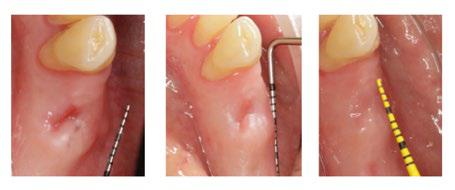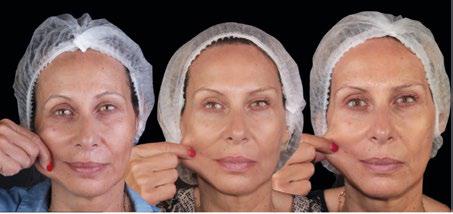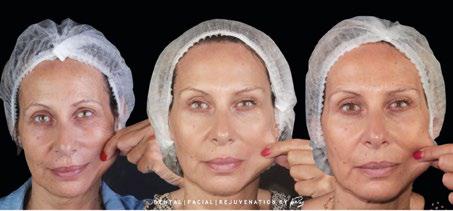Clinical results in dentistry are influenced by many factors and can be improved by taking advantage of the body’s natural mechanisms. It is fundamental to take into account the patient’s diet and supplementation, especially pre and post-operatively, as this has an impact on the healing of hard (bone) and soft (gum) tissues; however, there are methods to increase the body’s ability to regenerate by boosting its cellular activity.
Clinical results in dentistry are influenced by many factors and can be improved by taking advantage of the body’s natural mechanisms. It is fundamental to take into account the patient’s diet and supplementation, especially pre and post-operatively, as this has an impact on the healing of hard (bone) and soft (gum) tissues; however, there are methods to increase the body’s ability to regenerate by boosting its cellular activity.
Photobiomodulation therapy (PBM) uses laser light energy to stimulate regeneration in various areas of the body without side effects when applied to tissues in a non-invasive manner. There are several photobiomodulation devices and dental lasers with the PBM function (ATP38®, Integrated Dental Systems; Gemini™, Ultradent; Epic X™, Biolase). Although red light and infrared light (NIR) are the most widely used and studied, there are several wavelengths that can be used alone or in combination to reduce pain and inflammation and improve healing after extraction and periodontal procedures, accelerate therapy with orthodontic aligners, and facilitate a number of other aesthetic applications, including reducing dermal scarring, improving skin blemishes, and even reversing the effects of hair loss.
It is important to understand the differences and functionality of the different wavelengths available when treating patients with PBM. Blue, green, yellow, red and NIR light classifications cover a wide spectrum of wavelengths, with different levels of penetration and effects on tissues.
What is photobiomodulation?
PBM is defined as the use of non-ionising electromagnetic energy to trigger photochemical changes within cellular structures that are receptive to these photons. Mitochondria, which produce energy called adenosine triphosphate (ATP) for cellular use, are particularly receptive to this process. At the cellular level, energy from NIR and visible red light is absorbed by mitochondria, potentially increasing ATP production along with light reactive oxygen species, nitric oxide and cyclic adenosine monophosphate (cAMP), which can initiate cell proliferation. Reactive oxygen species also assist in cell regeneration and healing. This process unblocks the chain that has been obstructed by nitric oxide, which is then released back into the system. Nitric oxide is a molecule that the body produces to help cells communicate by transmitting signals throughout the body. In addition, nitric oxide helps dilate blood vessels and improve blood circulation. These effects may lead to increased expression of genes related to protein synthesis, cell migration and proliferation, anti-inflammatory signalling, anti-apoptotic proteins and antioxidant enzymes. There are studies suggesting that stem cells are particularly susceptible to PBM.
The key to the entire process is a mitochondrial enzyme called cytochrome c oxidase, a chromophore that accepts photon energy from specific wavelengths. As mitochondria absorb these wavelengths of light energy, producing more ATP energy, transport in cells is boosted. The resulting cell proliferation enhances the body’s natural regeneration process.
Wavelengths and effects
Light is measured in nanometres (nm) and expressed as a wavelength. Natural (white) light is a combination of several wavelengths. Specific wavelengths, however, have different levels of penetration and effects on the body after exposure and fall into specific bands of colours (Figure 1). As the wavelength increases, deeper penetration is observed and different tissues are affected, with NIR being the deepest penetration and ultraviolet the most superficial.
Light at the ultraviolet wavelength is typically between 100 nm and 380 nm and can cause burning and tanning; and has little or no effect on deeper tissues. However, superficial skin is the most affected and can result in skin cancer.
Blue light
The wavelength of blue light is between 450 nm and 470 nm, and clinical results have demonstrated benefits on inflammatory lesions in individuals with acne. This wavelength of light can induce both beneficial and adverse effects, depending on the dose and the width of the spectrum of exposure. There is controversy surrounding its use because the margin between “safe” blue light and potentially harmful ultraviolet light has not been well defined. The study showed that blue light can partially prevent skin flap necrosis and, when combined with red light, can increase skin flap survival by improving angiogenesis. Thus, the use of PBM with blue light can augment the effects of red light to aid the healing of incisions, cuts and other changes in surface tissue (skin and gum). Blue light has been classified as the light capable of stimulating the differentiation of keratinocytes, assisting in the restoration of the skin barrier function.
Green light
Green light has a wavelength of 510 nm to 540 nm and, when absorbed by the skin, helps to lighten hyperpigmentation spots, revealing a brighter complexion. Pigmented areas on the skin, such as brown spots or freckles, are caused by a variety of factors and can occur on all skin types. Hyperpigmentation is characterised by darker areas of the skin or gums related to the overproduction of melanin. The green wavelength targets melanocytes, the melanin-producing cells located in the deepest layer of the skin’s epidermis, inhibiting the production of excess melanin and preventing it from travelling to the skin’s surface, as well as breaking down melanin clusters to diminish existing discolouration. As a result, dark spots fade slightly as they blend in with the surrounding tissue tone. In addition, the light helps to increase cell growth, allowing the healing of wounds on the skin and gums. The effect also has anti-inflammatory properties that soothe the skin’s surface. Green light has shown a therapeutic effect on basal cell carcinoma. In addition, green light accelerates wound healing and has positive effects in the treatment of acne and other skin irritation problems. Blue and green wavelengths have been described to produce a stimulating effect with increased osteoblastic differentiation. The shallower depth of penetration of these two wavelength ranges works well in the oral cavity where the bone structure is below the gum tissue, with no intercalated muscle that can prevent contact with the bone.
Yellow light
Yellow light, which has a wavelength between 580 nm and 600 nm, reaches a slightly deeper penetration than blue and green light, reaching the dermal area and creating healing, anti-inflammatory, analgesic and regenerative effects. This wavelength is effective with skin conditions involving redness, swelling and other pigmentation-related effects. In vitro and in vivo studies have demonstrated the ability of yellow LED therapy to trigger skin collagen synthesis and reduce MMP (metalloproteinases) expression. Rejuvenation effects have also been studied. PBM treatment using light in the yellow range has been shown to be effective in treating acne and reducing dermal scarring. This also applies to the treatment of keloids. In addition, the yellow wavelength has been rated as an effective treatment for hair loss and baldness related to androgenetic alopecia and alopecia areata.

Fig. 1. Schematic representation of the different wavelengths and the different levels of penetration.

Fig. 2. Application of photobiomodulation with ATP38 after the placement of orthodontic aligners.

Fig. 3. Image A: Initial phase; Image B: Results after wearing aligners for 8 weeks with photobiomodulation sessions with ATP38 every week. The aligners were changed weekly.

Fig. 4. Image C: Initial phase; Image D: Result after wearing aligners for 8 weeks with the application of photobiomodulation sessions with ATP38 every week. The aligners were changed weekly.

Fig. 5. Postoperative application of photobiomodulation with ATP38 in combination with the administration of PRF in the post-extraction alveolus.

Fig. 6. Application of photobiomodulation with ATP38 during the postoperative period without the application of PRF.
Baseline
1st day after 2nd day after 3rd day after 1 week after 2 weeks after 1 month after



Fig. 7. Application of the Paz Protocol to improve skin quality and produce the lifting effect. Results in 4 weeks, combined with weekly photobiomodulation sessions.

Fig. 8. Application of the Paz Protocol to improve skin quality and produce the lifting effect. Results in 4 weeks, combined with weekly photobiomodulation sessions.

Fig. 9. Application of the Paz Protocol for acne treatment. Results in 2 weeks, combined with weekly photobiomodulation sessions.

Fig. 10. Application of the Paz Protocol for treating wounds and scars. Results in 2 weeks, combined with weekly photobiomodulation sessions.

Fig. 11. Application of the Paz Protocol for the treatment of pigmentation, spots and melasma. Results in 4 weeks, combined with weekly photobiomodulation sessions.
Red light
The wavelength of red light falls between 610 nm and 775 nm, and has been documented to provide healing to irradiated tissues with deep penetration into the skin and underlying structures, where cells can absorb and use it. Irradiation with red light generated a much lower amount of reactive oxygen species when compared to non-irradiated cells. Red light has been observed to aid wound healing through accelerated cell migration rate. This light modulates dermal fibroblasts to increase gene expression responsible for enhancing adaptive redox response, inflammatory balance and, additionally, those genes that play an important role in DNA repair processes. Red laser irradiation enhanced procollagen synthesis, collagen expression and fibroblast growth factor release.
NIR light
NIR light has a wavelength of 800 nm to 835 nm and affects two main chromophores: intracellular water and cytochrome c oxidase. In addition to photochemical effects, the use of NIR light also results in increased intracellular temperature. The biological response of the cell or tissue to irradiation with NIR light is in part caused by the thermal effect generated. At the cellular level, NIR activates cytochrome c oxidase, the primary mitochondrial photoacceptor of light. This activation results in several cellular responses, including increased mitochondrial ATP production. NIR light therapy demonstrated increased mitochondrial metabolism, with stimulation of angiogenesis of the skin and gums, improvement in bone quality, with stimulation of osteoblastic cell activity and regeneration of muscle tissues. Increased levels of ATP accelerate bone remodelling. This is related to the elevation of metabolic activity, and concomitant angiogenesis, increasing the blood supply required for remodelling. In addition, wound healing is more effective, so that incisions created during periodontal and oral surgery or traumatic injuries heal more quickly. It is common for pain to occur after surgery, as well as during orthodontic treatment when aligners (Fig. 2, Fig. 3 and Fig. 4) are changed or fixed braces are adjusted. NIR has demonstrated a reduction in pain and should be considered in those patients undergoing extractions, implant placement and periodontal procedures. In addition, a reduction in postoperative oedema has been reported, which also leads to reduced pain.
Combining wavelengths
PBM therapy combines different wavelengths of laser light energy and can be beneficial as an adjunct to various dental procedures. Both red light and NIR light have demonstrated an ability to accelerate orthodontic tooth movement by promoting alveolar bone remodelling on the compression side of the teeth. Photobiomodulation therapy used energy in the red spectrum to accelerate bone remodelling to a greater extent than NIR in an initial period. Over time, the use of the two wavelengths together provided better results than using only one single wavelength. In addition, the simultaneous combination of blue, green, yellow, dark red, red and NIR light can be used to treat a post-extraction alveolus (Fig. 5 and Fig. 6), or to help heal tissue after periodontal surgery. For dental practitioners offering facial aesthetic treatments, it helps with wrinkle reduction, improving skin tone, treating acne and skin blemishes, scar reduction, and more. Photobiomodulation therapies can also be performed using the combination of different wavelengths.
At White Clinic we are pioneers in the application of photobiomodulation therapy in facial aesthetics and in dentistry, in combination with PRF (Platelet Rich Fibrin), a protocol that we developed at White Clinic in 2016, called Paz Protocol. The Paz Protocol originated in dentistry to aid post-surgical recovery and accelerate healing. Beneficial effects on skin quality were quickly observed, so we decided to adopt this therapy and integrate it with the aesthetic medicine protocol with extremely positive results (Fig. 7, Fig. 8, Fig. 9, Fig. 10 and Fig. 11).
Conclusion
Extensive research has shown that PBM enhances the body’s responses by improving soft and hard tissue healing and regeneration. Its applications encompass healing of post-extraction alveoli, periodontal surgeries, acceleration of orthodontic treatment and osseointegration of implants and biomaterials, such as bone grafts. Dentists can consider photobiomodulation as a complement in the application of aesthetic procedures, as it is applied in the Paz Protocol; as well as to improve clinical results and, above all, to improve the comfort of the patient, as he/she may be able to reduce or no longer need to take medication for post-surgical pain and inflammation.
*Originally published in O Jornal Dentistry.




